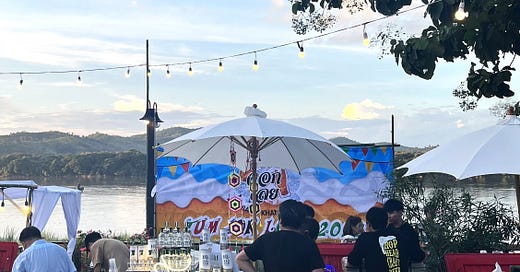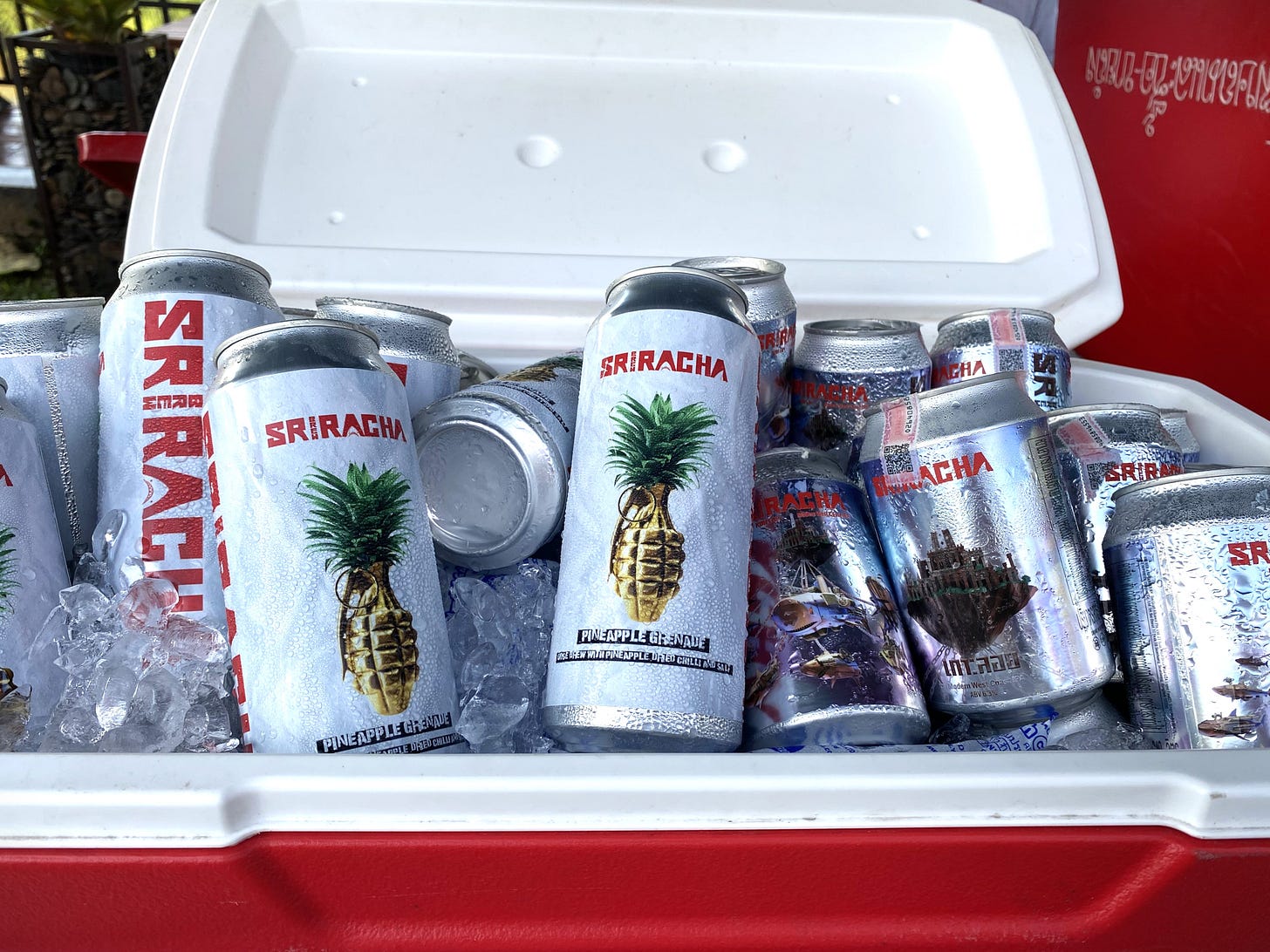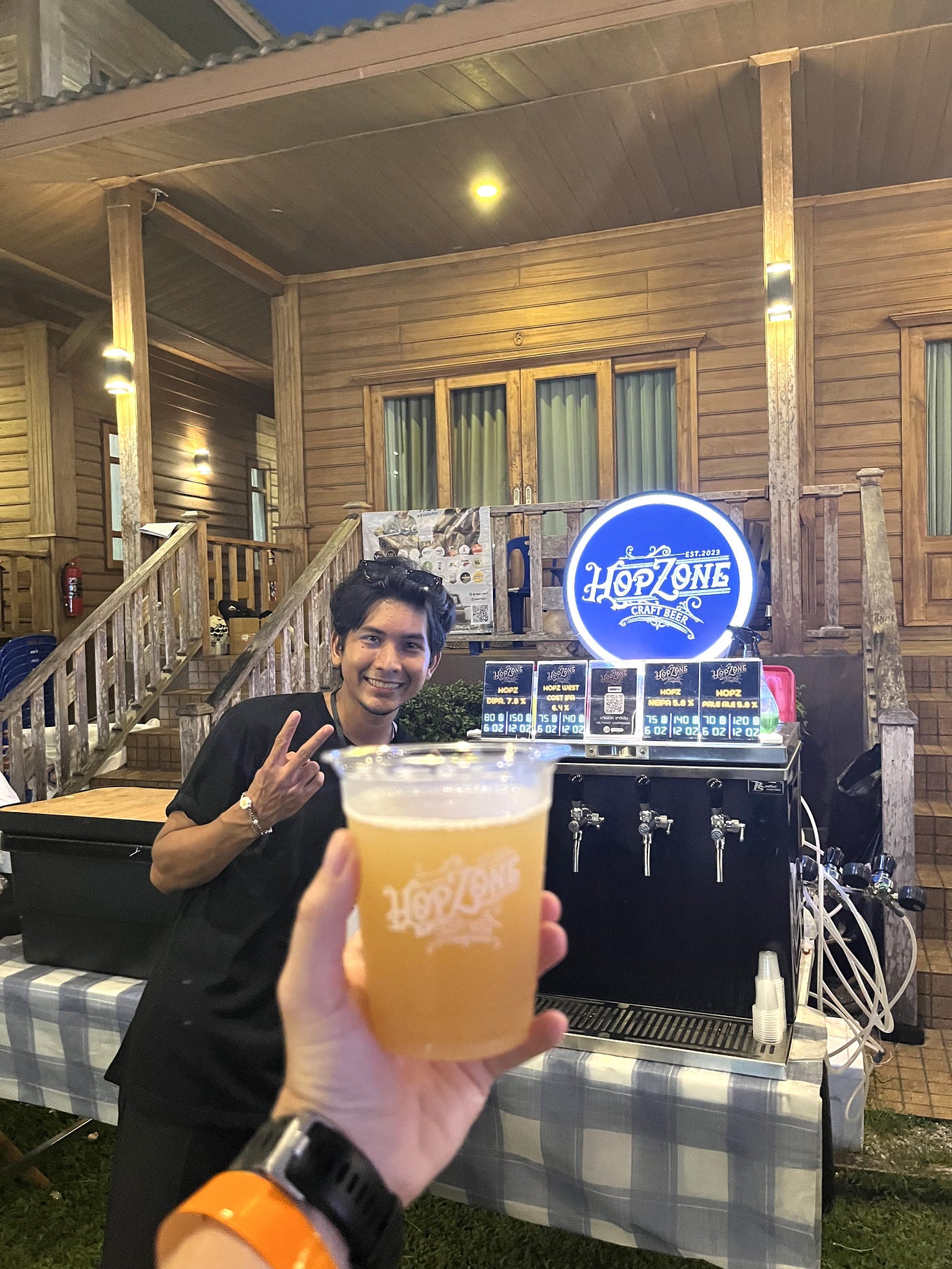Why are there suddenly so many beer fests?
On Thailand's abundance of beer events, what they offer the country, and why they're very different from the ones you've experienced elsewhere.
Fresh air, good views, and plenty to eat, drink, and do—Tam Jok Loei was a blast.
When I lay out the events of my life so far, it seems inevitable that I would one day find myself downing a pineapple-chili gose as my wife and I Elaine-danced to molam beside the Mekong.
I moved to Thailand in 2011 with two bottles of piney Ninkasi beer in my suitcase, fearing I wouldn’t taste another West Coast IPA for a very long time. Since then, I’ve traveled to nearly every Thai province and had more great beers in this country than I can count (including Ninkasi IPAs).
When I learned about Tam Jok Loei, a beer festival taking place in Chiang Khan—a quaint town of temples and timber houses bordering Laos—I had, for the sake of both this newsletter and my own personal interests, a valid reason to return to one of my favorite places in Thailand. The experience, of course, did not disappoint.
As the sun sank into the hills behind Chiang Khan, I stood in the golden light by the Mekong, drinking Outlaw Brewing’s Nectropolis, an excellent double dry-hopped New England IPA. Gradually the grass lawn behind La Moon resort’s wooden villas filled with guests, including Wichit “Chit” Saiklao and Taopiphop Limjittrakorn, two of the biggest public faces of Thailand’s beer liberalization movement.
Bands played, people danced, and the party went on into the night. Before the light behind my eyes began to dim, I got a chance to talk to a dozen or so brewers and try everything from Daddy Dog’s double IPA to a tamarind cider made by Khao Kho.1
I woke up with a hangover the next day. I imagine local officials did not, though. Events like Tam Jok Loei generally give cities something to celebrate for months, if not years, after they happen.
What happens when the beer geeks come to town
Beer festivals have a lot of auxiliary benefits for the places where they’re held. Namely, money and jobs. These are generally created without the need to build infrastructure, which means there’s no lingering economic burden for the communities. Even the post-event messes typically get cleaned up by the organizers.
Northumbria University researchers calculated that the Knavesmire Beer Festival, a four-day beer bash held in York every year, brings GBP 1.2 million (US$1.45 million) to the English city and creates around 18 full-time jobs. The socioeconomic impact of Oktoberfest—the world’s biggest beer festival—is, of course, massive.
Every year, Oktoberfest generates more than 1 billion euros (US$1.05 billion) for Munich and Bavaria.2
What beer fests have offered Asia isn’t quite so clear. Not yet, at least.3 But it seems almost certain that smaller destinations like Chiang Khan enjoy downstream benefits when the beer geeks come to town.
One of the live acts at Tam Jok Loei later in the night, as things were getting fuzzy.
Hotel rooms were in hot demand when Tam Jok Loei took place. The property we stayed at was fully booked—and it was able to double its rates that weekend.
As Mike Roberts, founder of Outlaw Brewing and one of the organizing partners for Tam Jok Loei, told me, the festival was meant to benefit more than just beer drinkers.
“The concept was to bring all the things we love that are unique to the area—amazing Isaan food, molam music, and local brewers—at a venue on the Mekong,” he said. “We tried to keep the atmosphere warm and cozy like a backyard party.”
It also offered Loei residents something unique to do on the weekend and helped local businesses attract new customers before and after the event.
Going big in Bangkok
Before Tam Jok Loei, Roberts and organizing partner Tonkla “Jo” Niyomtrusa, founder of Chiang Khan’s Jo+ Beer—and a man many have told me is considered the godfather of Thai craft beer in Isaan—anticipated about 300 visitors. The eyeball test suggests they hit that mark. In big cities, though, beer festivals can aim higher.
Singapore’s Beerfest, which bills itself as Asia’s largest, totaled about 30,000 visitors over its three-day run in June this year, according to the organizers. In November, Beerfest is coming to Bangkok under a different name: Brewtopia.
The three-day event that might end up being Bangkok’s biggest beer festival to date. It promises dozens of food vendors, 300-plus beers to try from many local and international brands, and professional stages set up for Thai artists like Polycat.
Brewtopia is taking place in Sermsuk Warehouse, a sprawling concrete expanse wedged between the King Taksin Bridge and The River, a luxury condo overlooking the Chao Phraya. Big enough to house navy ships, not to mention accommodate thousands of craft beer stans, the venue regularly hosts large-scale events, ranging from the Made by Legacy flea markets to something called Babe Fest.4
If the venue alone doesn’t divulge the ambition, you can tell the organizers are aiming high because the event has already been listed in magazines like Time Out and The Beat. That doesn’t happen for, say, an event featuring more than a dozen brewers and distillers in Samut Sakhon. It’s hard to see it any other way: Brewtopia clearly signals an awareness of the economic prospects of hosting a major beer festival in Thailand.
An unquenchable thirst for beer (events)
The aforementioned pineapple-chili gose.
One thing you don’t find in the US or the UK: beer festivals every weekend. In Thailand, a country roughly the size of Texas, they’re non-stop right now.
From small events in Surin and Rayong to hot, heaving bashes that drew attendees by the hundreds to Changchui, the Jam Factory, and Jatujak Market in Bangkok, Thailand’s beer community seems to be trying to host as many festivals as possible.
By my count, there were a dozen in October alone.
The same day as Tam Jok Loei, there was one festival in southern Thailand and another in Chiang Mai. The following weekend, Khao Kho hosted a beer-and-music blowout while there was “backyard party” with a bunch of brewers in Hua Hin.
Beyond the volume of beer fests, what’s most interesting is the diversity of them.
“At craft beer festivals in England, you commonly pay a set amount for entry, and then you can drink samples of any beer for three or four hours,” says Ben Dickins, a former brewer at Wild Beer Co, who currently works in sales for Hoppiness Distribution and helps manage guest relations at Mikkeller Bangkok.
“Sometimes they’ll see the token system, too,” he adds. “Basically, you buy tokens, and that’s your currency for the event. One token might buy you a half pint of something boring, like a session bitter.”
Free-flow, limited-session events charge much higher fees than what you’ll find in Thailand. The Mikkeller Beer Celebration in Copenhagen (MBCC), for example, starts at DKK 495 (US$70) and climbs to DKK 2,995 (US$423) for VIP access to every session.
“That style of festival works out well for the breweries, though,” says Dickins. “Breweries sell their beers to the event organizers, and usually the brewers themselves will show up to pour their own beers, so they get to speak about their products and give away as much of it as they want because it’s already been paid for.”
In Thailand, there’s been a little from column A, a little from column B, and a whole lot of columns C-Z, too—but certainly nothing that costs US$400.
The Good Chit Beer Fest in September, for example, offered free-flow pours from 12 taps for THB 1,500 (US$40).5 The Beer Markets, on the other hand, have become sort of “rising tide floats all boats” events that are neither ticketed nor tokened.
They’re organized by Prachachon Beer, a.k.a. “Beer People,” a group whose modus operandi is to make Thai beer (and spirits) more widely known. Unsurprisingly, they’re free to enter, and booth space, if the rumor mill is true, tends to be reasonably priced. Vendors set their own prices and are encouraged to sell beer for take-away.
They’re basically giant parties celebrating the spirit of the craft movement that aim to put more Thai beer in your fridge (and down your throat).
Tam Jok Loei was closer to the Beer Market in spirit. It was a ticketed event that aimed for affordability and diversity to support small local businesses. Entry cost THB 300 (US$8). Vendors paid for booth space and set their own prices.6 If they wanted to give away or share beer, they were free to do it. They all offered samples, too.
Market forces mean more beer events
Hop Zone is, as the logo suggests, one of the many new brewers entering Thailand’s red-hot beer market.
As Dickins explains, in places that have well-developed and relatively liberalized industries, the market economy has wrapped its tentacles around beer events.
We Are Beer, he points out, organizes many of the UK’s biggest beer festivals. “Not only are they for-profit, but they’ve also started creating their own beer subscription boxes made up of their festival favorites to sell to you after the fact.”
Thailand’s craft community isn’t in a space to profiteer off a luxury item that’s still really hard to produce in the country. Let alone use festivals to raise funds for charitable causes—not when people are still threatened with fines that amount to the price of a new Tesla.7
That’s why most events still champion homebrewers and local communities. And it might be why there are so many of them right now.
“I’m not sure the what’s behind all the events,” Roberts admits, “but it’s likely due in part to the draconian brewing and advertising laws. These events, for many brewers, are their only opportunity to sell their beer and get their brand out there.”
He says Tam Jok Joei served as a low-key networking event, allowing him to reconnect “with all the old-school brewers I hadn’t seen since before Covid,” plus meet up-and-coming brewers. I noticed several there had “established in 2023” signs in their logos, including Hop Zone, the Surin-based brewer pictured above.
Tam Jok Loei also illuminated the potential of beer tourism, a sub-genre of regular old tourism that has created new revenue streams for destinations ranging from Prague to Oregon. Beer events could have a sizable impact on secondary Thai destinations, in particular.8 The more time, money, and attention that towns off the beaten tourist trail—towns like Chiang Khan—receive, the better.
Above all, though, more beer events mean more opportunities to rally fence-sitters to the side of the liberalization movement. It’s a tricky needle to thread, though. The festivals are clearly helping to destigmatize the industry, hence the reason they’re so popular these days. But the threat of life-altering fines is still very real, and the politicized nature of beer in Thailand is still, let’s just say, a thing.
The first Beer Market in March 2023 had to be moved to a car park by Jatujak Market when the original host backed out, citing the sensitive nature of the political talks they had planned. No matter. Hundreds of people showed up to it, and Prachachon Beer has continued to host talks and parties and make festival appearances.
When I talked to Thanakorn “Benz” Tuamsa-ngiam of Prachachon Beer in August, he told me that they’re being cautious about how they promote their events. But he also said with full-throated assurance that they intended to keep organizing them, too.
Just don’t expect them to be backed by venture capital or corporate sponsors.
I’ll spare you the rundown of every beer I tried, but I’ll just say this: many were consumed.
Oktoberfest attracts about 6 million visitors every year. That’s about twice the number of people who attended the 2022 FIFA World Cup. #themoreyouknow
Any economists eager to dig into this?
shrug emoji
These were only Chit’s beers, mind you. Also, the proceeds presumably went to the hotel that hosted the event, but I’m just spit-balling here.
Most were about THB 150-200.
Put another way, you could say the proceeds from beer events are like a real-life GoFundMe.
Having done so myself, I can assure you that few things in life top having a delicious gose while soaking up the sunset beside the Mekong.







